If you have ever purchased crystal power items for your heroes, it’s important for you to understand how Broken Myth can impact your damage output. Broken Myth recently received a heavy revision with the release of Celeste (v1.2.0) and I believe it’s an overall improvement to the item. However, Broken Myth is widely misunderstood, both in how it works and when it should be purchased. As I’m writing this, there are multiple threads on the topic of Broken Myth on the front page of the general forums. My objective is to help everyone become much clearer on how to use it and when to buy it.
How it works
Before I jump into the analysis of the item, we need to make sure you have a baseline knowledge of how the item operates, which is a source of confusion for many. Here’s the official item description:
- +20 Crystal Power
- +10% Shield Pierce
- Passive: Gain 5% shield pierce per second whenever you are in combat with heroes, turrets, or Kraken. After 5 seconds, you lose a stack each second. 5 stacks max.
I can see why players might be having difficulties with this. The description of the passive leaves many questions on the table:
- Under what circumstances am I considered “in combat?”
- Can I only build stacks by using my abilities?
- Do I need to be constantly attacking and using abilities to build stacks (like Breaking Point)?
- I start losing a stack per second “after 5 seconds” of what? Of being in combat? Of being out of combat? After 5 seconds of staring at my screen in confusion?
First, let’s start with the obvious. You begin with 10% shield pierce and you can build up to five stacks of additional shield pierce at 5% per stack, giving you a maximum of 35% shield pierce with max (5) stacks. Now, the real question: “How do I build and maintain these stacks of additional shield pierce?”
You build a stack each time one of the following happens:
- You damage a tower, an enemy hero, or the Kraken.
- You are damaged by a tower, an enemy hero, or the Kraken.
When I say “damage”, I mean it in its most broad and liberal form. Damage could take place via abilities or basic attacks. As long as that damage is being dealt to or dealt by an enemy hero, tower, or Kraken, you will build an additional stack of shield pierce. That being said, no matter how frequently you are dealing damage or being damaged, you cannot build more than one stack per second.
Some interesting ways you could build/use stacks for Broken Myth:
- Basic attacks. You could build stacks by harassing your opponents with random basic attacks. In preparation for using your abilities on an enemy hero, you could also build up stacks by laying a few basic attacks on a nearby tower or Kraken,
- Damage-over-time effects. Skaarf’s Spitfire, Adagio’s Gift of Fire, Taka’s X-Restu, etc. – i.e. any ability that continues to deal damage for a short while – will generate a Broken Myth stack for you every second that it’s active. As an example, if you catch an opponent within the area of your Gift of Fire, you will continue to gain a stack for each second they’re burning. As another example, if you place a Skaarf Goop underneath a tower and ignite it, you will build additional stacks of shield pierce for the next 4-6 seconds.
- Taking a beating. You could be running away from an enemy hero that is attacking you and then, after 5 seconds of building stacks, suddenly turn around and hit him in the face with 35% shield pierce.
- Any combination of the above. Broken Myth is incredibly relaxed when it comes to building stacks. In my testing, the one thing that did not build stacks was the damage from scout traps.
Now that you have a more thorough understanding of how stacks are built, let’s talk about how stacks are maintained and/or lost. There is a 5-second timer that is refreshed each time you deal damage to or are damaged by a tower, enemy hero, or Kraken. If at any point that 5-second timer ticks down to 0 without any of the aforementioned damage transactions, you will begin to lose one stack per second. If at any point during the loss of stacks, you deal damage to or are damaged by heroes/towers/Kraken, you will immediately gain another stack and the timer will once again reset to 5 seconds.
This 5-second timer allows you to be very flexible with how you build and maintain your Broken Myth stacks. It’s nothing like the rigorous and demanding process of building stacks on Breaking Point, where you’re losing stacks every second that you’re not attacking. With Broken Myth, you can even build up your stacks intermittently. In other words, you might build your first stack by taking damage from a tower, then two seconds later perform a basic attack on that same tower to build a second stack, then four seconds later use an ability that burns an enemy hero with a 3-second duration, thus eventually maxing out the remainder of your stacks. After that, maintaining your stacks is just a matter of regularly (every 5 seconds) doing damage or receiving damage.
When to use it
Typically, you’ll never want to build a Broken Myth before you and your opponents reach level 12. However, some players have the false impression that Broken Myth should only be purchased when the opponents are building high shield defenses – it’s actually much more complex than that. When you’re trying to decide between buying more crystal power (e.g. Shatterglass) or buying shield pierce (e.g. Broken Myth) there are three major variables at play:
- The shield defense of your target – the larger the amount of shield, the more your crystal (ability) damage is reduced and the more likely shield pierce will be more effective than additional crystal power.
- The base damage of your ability – the higher the base damage of your ability, the more likely shield pierce will be more effective than additional crystal power.
- The crystal power ratio your ability – the higher the crystal power ratio of your ability, the more effective additional crystal power will be the less likely shield pierce will be more effective.
Let’s talk about each of these in a little more detail.
Shield Defense
As rule-of-thumb benchmarks, an opponent with 100 shield will cut your crystal damage by 50% and an opponent with 200 shield will cut your crystal damage down to 33%. Another important rule-of-thumb is that an average level 12 hero has approximately 80 shield without any items. This means that at level 12 your crystal damage will be almost cut in half (45% to be exact) even if the opponent doesn’t build additional defensive items.
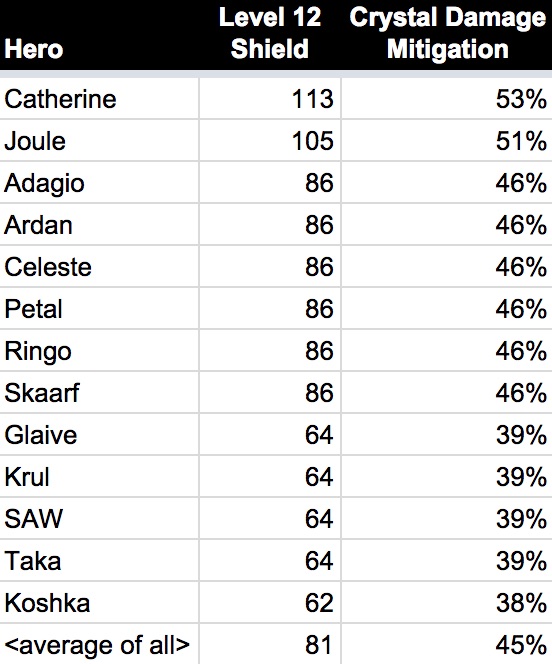
Base Damage and Crystal Power Ratio
If you haven’t given a detailed look at the stat block of an ability before, here’s the two key numbers I’m focusing on for this article: base damage and crystal power ratio.

Using this example, rank 5 of this ability will do 410 base [crystal] damage with an additional 120 points of of crystal damage for every 100 crystal power (or 1.2 crystal damage for every 1 crystal power).
Here’s a comprehensive list of abilities, base damages, and crystal ratios. Understanding this will help set the stage for the performance analysis that will follow.
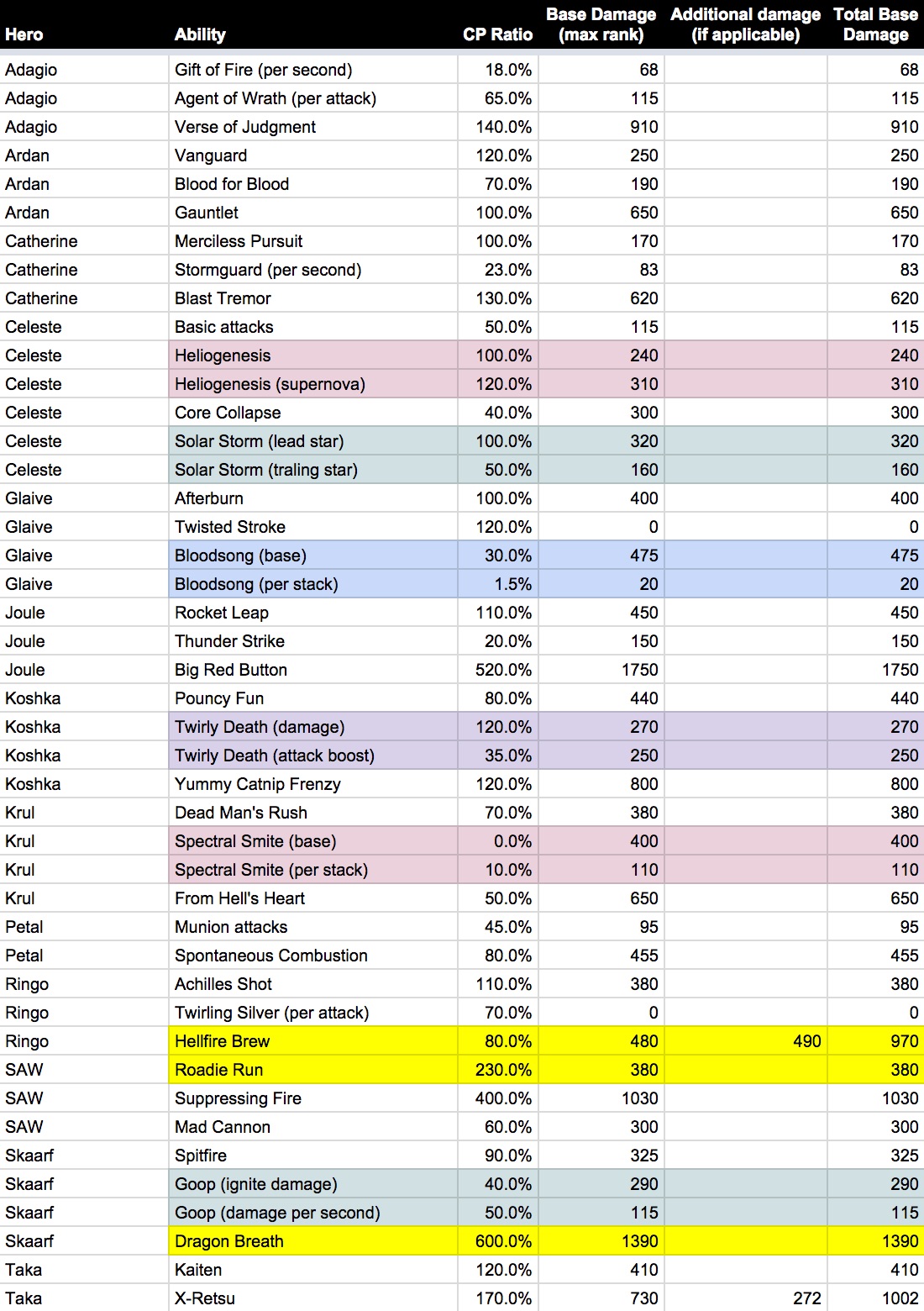
There’s a few things I’d like you to observe here:
- There are only 4 abilities in the entire game that have greater than a 200% crystal ratio. These abilities will benefit more dramatically from additional crystal power, making Broken Myth a less valuable choice.
- There’s about 8 abilities that have less than 50% crystal ratio. It is expected that these abilities will have a higher probability of benefiting from Broken Myth than purchasing additional crystal power.
- There are 10 abilities that have what I’d consider high base damage (i.e. greater than 600). These abilities will typically benefit most greatly from a Broken Myth, with the exception being that some of these also have high crystal ratios.
- When determining whether to buy a Broken Myth or more crystal power, the abilities highlighted in yellow will defy the three rules of thumb I just established:
- Ringo’s Hellfire Brew does “true damage” which means it ignores all armor and shield defenses, so Broken Myth provides no value here.
- Skaarf’s Dragon Breath comes pre-built with a lot of shield penetration (45% at max rank) and an extremely high crystal power ratio, making it hard for Broken Myth to compete.
- SAW’s Roadie Run has the potential to scale much more off of the missing health of an opponent and artificially increasing it’s base damage well beyond 600, so Broken Myth can be a more appealing option for increasing damage output than Shatterglass.
- Lastly, 2 of the abilities – Twirling Silver and Twisted Stroke – have absolutely no base crystal damage and could potentially be excluded from this line up; however, I decided to be thorough.
Two additional notes for understanding the chart:
- There’s 6 abilities that have two parts to their damage output with separate base damages and crystal ratios. I’ve split these abilities into two rows and grouped them together by highlighting in a pastel color.
- There are 2 abilities – Hellfire Brew and X-Retsu – that have a static damage-over-time component that does not scale with any sort of crystal ratio. Rather than creating a separate row for this additional damage, i’ve split their damage into two columns and totaled it in the column to the far right.
Baseline Performance Analysis
Let’s compare how well each of these abilities benefit from Shatterglass vs. Broken Myth when you’re up against opponents with no shield defense items (i.e. just the base 80 shield at level 12):
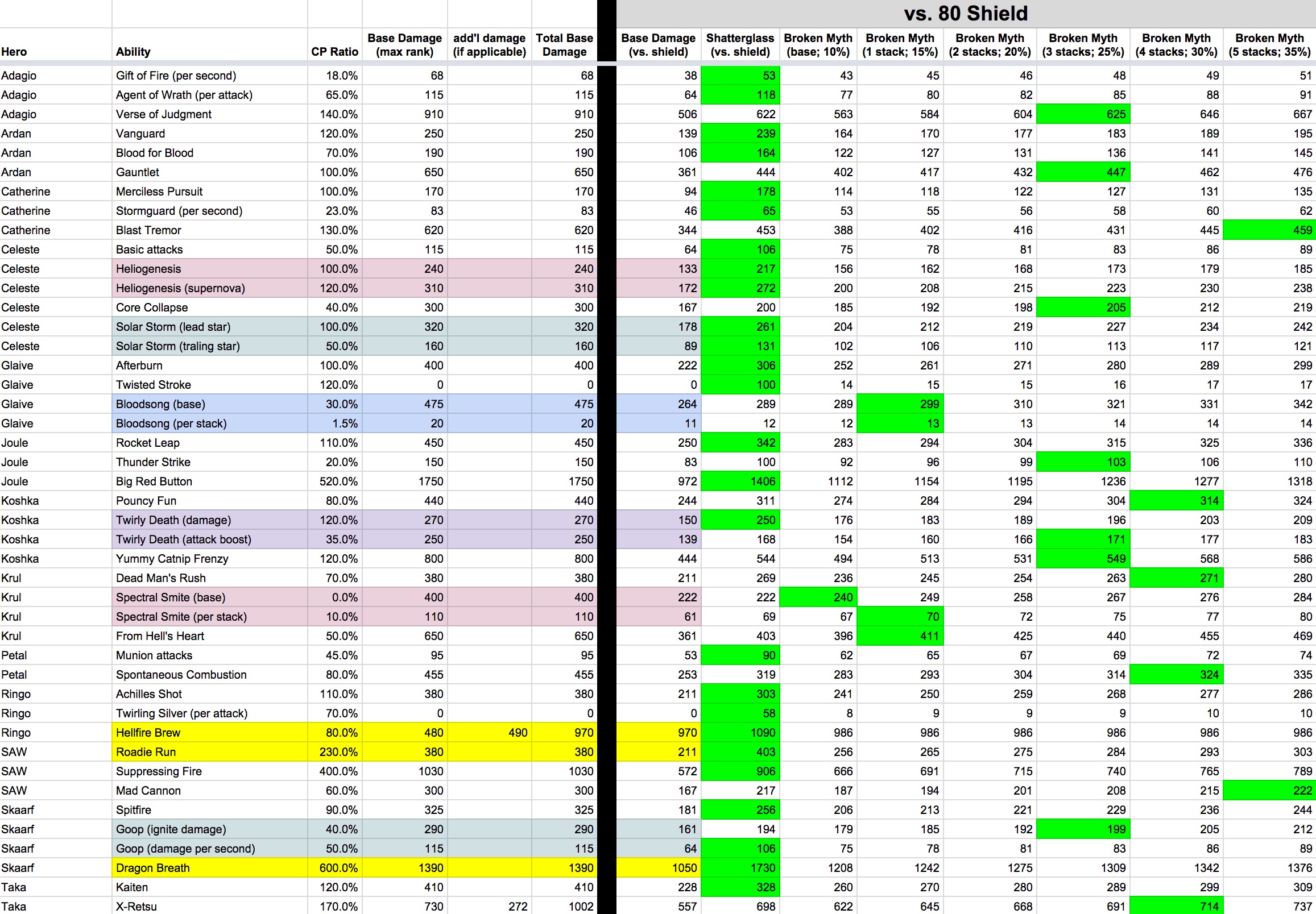
What you’re seeing (after the vertical black line; from left to right):
- Base damage after being mitigated by 80 shield.
- Total damage if a Shatterglass was purchased. This is calculated by multiplying the 150 crystal damage by the crystal ratio, adding that number to the base damage, then mitigating the new total by 80 shield.
- Total damage if a Broken Myth was purchased. I’ve divided the Broken Myth into 6 different scenarios (columns), representing the damage output with 0 through 5 stacks. Within this calculation, I have included the 20 crystal power that comes with Broken Myth and multiplied it by crystal power ratio for each ability.
For each row, I have highlighted a single field with green:
- If I highlighted the field in the Shatterglass column, that means Shatterglass will always outperform Broken Myth under the given circumstances (i.e. against 80 shield with no additional crystal power items).
- If I highlighted one of the Broken Myth fields, I highlighted the field with the lowest amount of stacks that outperforms Shatterglass.
In summary:
- There are 44 ability rows and 18 of them can see greater benefit with Broken Myth than with Shatterglass. A majority of these, however, will require you to build 3 or more stacks on Broken Myth to generate those results. This isn’t necessarily a bad thing, just an observation.
- As indicated earlier, many of the abilities with high base damage (greater than 600) can see value from Broken Myth: Verse of Judgment, Gauntlet, X-Retsu, Blast Tremor, Yummy Catnip Frenzy, and From Hell’s Heart.
- Likewise, abilities with low crystal ratios often see better benefit with Broken Myth than with Shatterglass, namely Bloodsong, Thunderstrike, Goop, Core Collapse,and Spectral Smite.
- None of the abilities with high crystal ratios (greater than 200%) find Broken Myth to be a suitable replacement for Shatterglass. These include Dragon Breath, Big Red Button, Suppressing Fire, and Roadie Run.
Deeper Performance Analysis
Now, there’s two different ways in which these baseline numbers could get more favorable for Broken Myth:
- Opponent builds additional shield defenses. I think this is the obvious one here. Additional shield will reduce both the effectiveness of current crystal damage as well the effectiveness of additional crystal power, also diminishing the value of the ability’s crystal ratio.
- Increase the base damage of the ability. Remember how abilities with high base damages benefit more from Broken Myth? Well, buying additional crystal power will eventually increase the damage of the ability to a point where Broken Myth would become the more effective choice.
Let’s begin by modeling out how this chart will change if your opponent builds additional shield defenses. Since an Aegis (+110 shield) is the ultimate counter to crystal damage and Broken Myth is meant to counter shield defenses, let’s use a less obvious scenario to show how shield defenses can impact the need for Broken Myth. Fountain of Renewals and/or Kinetic Shields both offer +60 shield defense are fairly common defensive items. In combination with the base shield of an average level 12 hero, that puts a target at 140 shield (58% crystal damage mitigation).
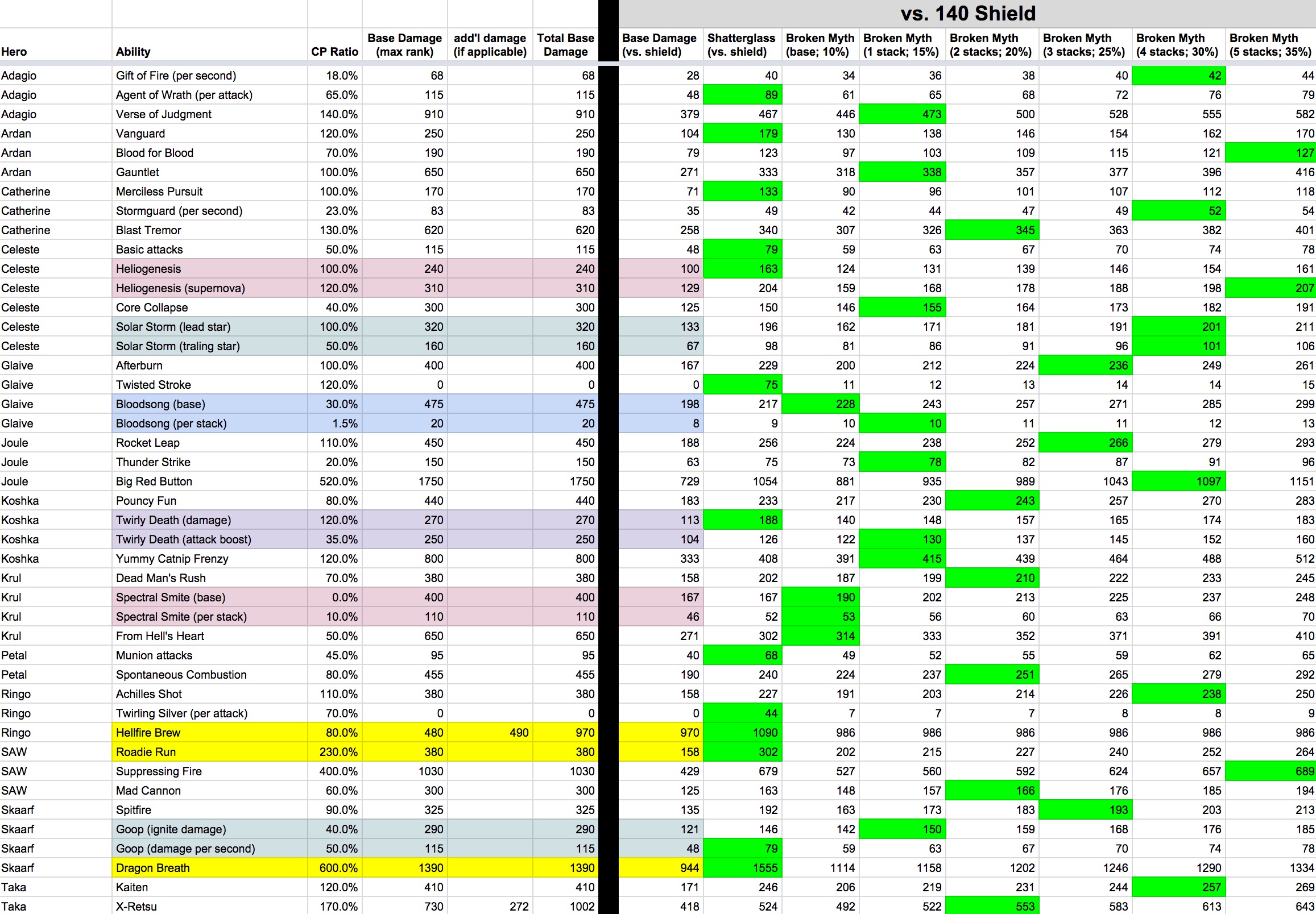
By adding only an extra 60 shield, 31 ability rows (up from 18) show Broken Myth proving superior damage output to Shatterglass, a majority only requiring one or two stacks of shield penetration. With full stacks, Broken Myth allows some of these abilities to do a full 25% more damage than they would with a Shatterglass.
In our final example of the day, we’re going to assume our target is back at base 80 shield again and that we’ve already purchased a Shatterglass, thus artificially increasing the base damage of all our abilities. The following model shows whether it would be more advantageous to buy a second Shatterglass or to pick up a Broken Myth instead.
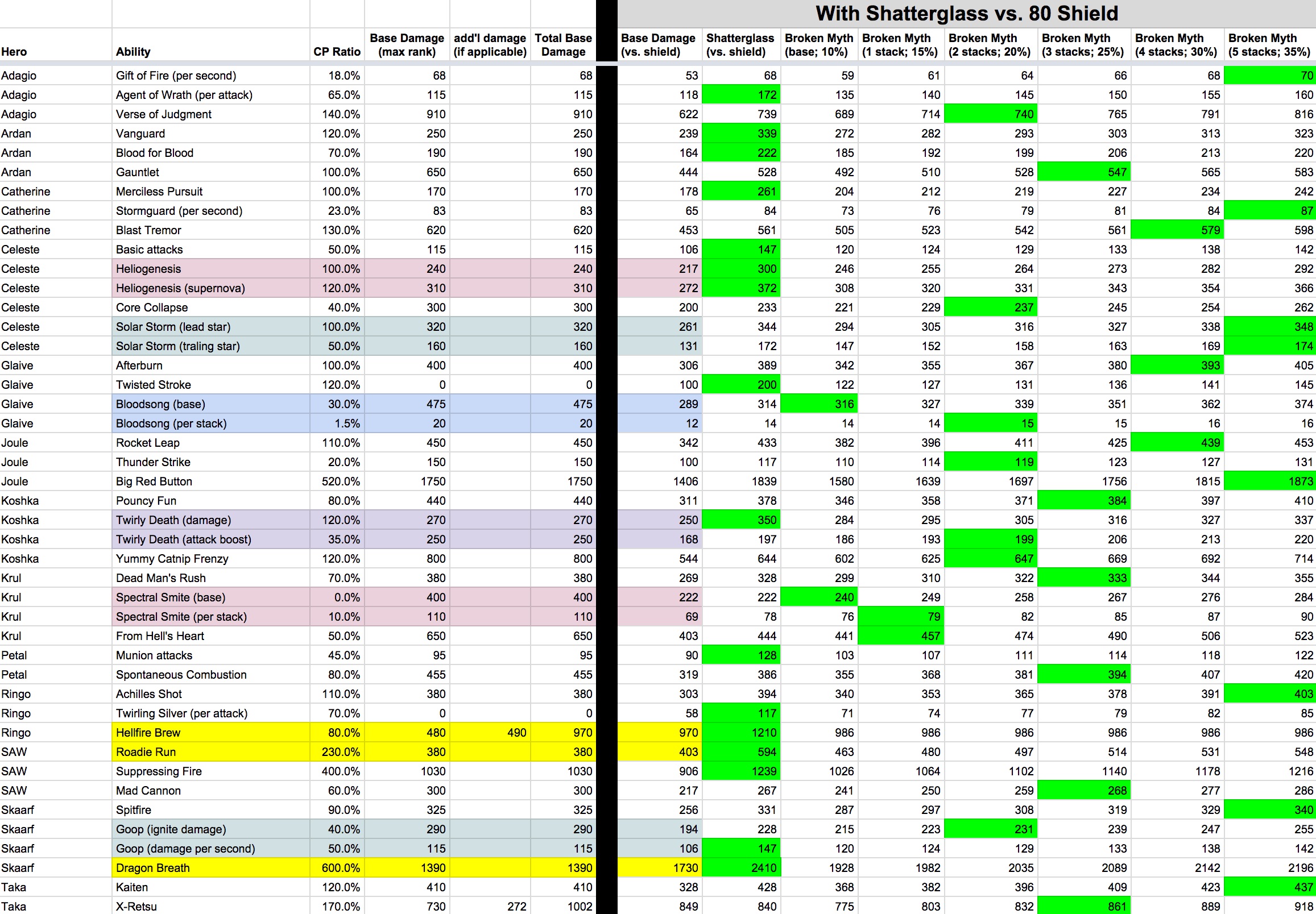
You’ll notice that while 80 shield remains the same, adding some initial crystal power via a Shatterglass has changed the picture from what we saw in our baseline performance analysis. Now we observe that 28 ability rows (up from 18) would benefit more from a Broken Myth than from purchasing a second Shatterglass. If you were to exclude some of the extreme [special] cases that were mentioned earlier – Dragon Breath, Hellfire Brew, Twisted Stroke, Twirling Silver – that means a full 75% of the abilities could be best optimized via a Broken Myth in this particular scenario.
Conclusion
I feel like I’ve learned a lot on this latest mathematical adventure: how shield values, base damages, and crystal ratios all play a part in determining if Broken Myth will be a valuable addition to your inventory. Do keep in mind that just because I highlighted a Broken Myth column in green doesn’t necessarily mean you should go out and buy it every time. For example, some heroes and play styles are not very accommodating for building up and using the stacks on Broken Myth, such as assassin heroes who want to jump in and then get out without much time to build stacks. I also didn’t account for other forms of crystal damage that may benefit from Broken Myth, such as the passive abilities of Aftershock and Alternating Current.
I hope you’ve found this useful and, as always, feel free to hit me up with questions and feedback.

3 Comments
Inkeyes
Mar 12, 2015 6:14 pmExcellent info! I learned so much! Just want to refer back to your video about Taka and the max burst article. Does it still make sense to for broken myth to be the third item? From the diagram with 140 shield, it seems like shatterglass has overtaken that initial burst? Does that make sense or am i missing something? Thanks for the post!
Gadianton
Mar 12, 2015 9:58 pmThe topic of Taka and max burst build is a tricky one. The new Broken Myth caters to people who stay in combat more than a few seconds, but my burst build is about cycling through abilities in about two seconds and then getting out for things to come off cooldown again. The problem is that since the new Broken Myth doesn’t really help him too much, he can get shutdown pretty hard by shield defense with no way to counter it.
This leaves us with a few ideas that I’m tossing around:
* Purchase two Piercing Shards rather than a single Broken Myth. However, with only six items slots, this would get very cramped and maybe impossible to manage.
* Since base damages are already pretty high, focus on cycling through abilities more rapidly by doing Broken Myth, Clockwork, Clockwork, Aftershock. This would allow you to maintain a farily high damage output, but through smaller, more frequent bursts, also keeping cooldowns low enough that you can maintain your Broken Myth stacks with ease.
* Start building tanky weapon builds (which I’ve been experimenting with)
AdyEndrus
Mar 12, 2015 5:26 pmThat was a great read! I liked the examples and felt they were really relevant. I was worried there wouldn’t be a comparison where the hero already had existing crystal power. I also like that you mentioned certain abilities that do percentage damage and explain that they will benefit more from shield pierce than they potentially would by just buying more crystal power.